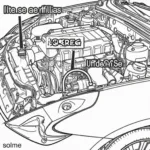Understanding Honda OBD2 engine codes is crucial for effective vehicle maintenance and repair. Whether you’re a seasoned mechanic or a car enthusiast, this guide provides valuable insights into interpreting these codes and troubleshooting potential issues.
Honda, like other car manufacturers, utilizes the OBD2 (On-Board Diagnostics II) system to monitor various vehicle components and detect malfunctions. When an issue arises, the system generates a specific alphanumeric code, providing a clue to the problem’s nature. Knowing how to decipher these codes empowers you to address the root cause of the problem swiftly and efficiently. You can learn more about specific Honda OBD2 trouble codes by visiting our dedicated page on obd2 trouble codes honda.
What are Honda OBD2 Engine Codes?
Honda OBD2 engine codes are standardized diagnostic trouble codes (DTCs) specifically related to the engine and its related systems. These codes, defined by the Society of Automotive Engineers (SAE), follow a specific format. The first character indicates the system involved (e.g., “P” for powertrain), the second character specifies whether the code is generic or manufacturer-specific, and the remaining digits pinpoint the specific issue.
Understanding the Structure of Honda OBD2 Codes
Deciphering these codes is like unlocking a puzzle. Each part of the code tells a story. For example, P0301 indicates a misfire in cylinder 1. Knowing this allows you to focus your diagnostic efforts on that specific cylinder, saving time and effort. Do you have a complete list of codes? Check our comprehensive list of honda obd2 codes for more information.
Common Honda OBD2 Engine Codes and Their Meanings
Several Honda OBD2 engine codes frequently appear. Let’s explore some of the most common ones:
- P0135: Oxygen Sensor Heater Circuit Malfunction (Bank 1, Sensor 1)
- P0300: Random/Multiple Cylinder Misfire Detected
- P0400: Exhaust Gas Recirculation Flow Malfunction
- P0171: System Too Lean (Bank 1)
- P0172: System Too Rich (Bank 1)
These codes indicate potential problems with various components, including oxygen sensors, fuel injectors, and the EGR system.
How to Read Honda OBD2 Engine Codes
Retrieving the codes requires an OBD2 scanner, a readily available tool at most auto parts stores. Connect the scanner to your vehicle’s OBD2 port (usually located under the dashboard), turn the ignition on, and follow the scanner’s instructions to read the stored codes.
Using an OBD2 Scanner Effectively
Using an OBD2 scanner isn’t rocket science. Most scanners are user-friendly, providing clear instructions and definitions of the codes. Remember to write down the codes and their definitions before clearing them from the system.
“Using the right OBD2 scanner is essential for accurate diagnostics,” says John Davis, a seasoned automotive technician. “Invest in a reliable scanner that can provide detailed information beyond just the codes.”
Troubleshooting Honda OBD2 Engine Codes
Once you’ve identified the codes, you can begin the troubleshooting process. This involves systematically checking the related components and systems, using diagnostic tools and procedures to pinpoint the exact cause of the problem. If you’re swapping an engine, knowing OBD2 information is vital. Check our guide on obd2 h22 in obd1 accord for related information.
Systematic Diagnosis for Effective Repairs
Troubleshooting effectively requires a structured approach. Start by checking the most likely culprits based on the code, and work your way through the system until you identify the root cause.
Preventing Honda OBD2 Engine Codes
Regular vehicle maintenance is the key to preventing many OBD2 codes. This includes routine oil changes, air filter replacements, and spark plug checks. Addressing minor issues promptly can prevent them from escalating into major problems. Where’s the OBD2 port located? You can find information on the obd2 location on 2017 honda accord on our site.
Proactive Maintenance for Optimal Performance
“Preventative maintenance is not just about avoiding costly repairs,” adds Maria Sanchez, a certified mechanic. “It’s about ensuring optimal engine performance and extending the life of your vehicle.”
 Preventive Maintenance for Honda Engines
Preventive Maintenance for Honda Engines
Conclusion
Understanding and addressing honda obd2 engine codes is essential for keeping your Honda running smoothly. By utilizing the information provided in this guide and using the appropriate tools, you can effectively diagnose and resolve engine issues, saving time and money in the long run. Don’t forget to explore our resource on honda obd2 fuel injectors resistance for additional information on fuel injector troubleshooting.
FAQ
-
What does the “P” in a Honda OBD2 code represent?
- The “P” stands for Powertrain, indicating that the code relates to the engine, transmission, or other drivetrain components.
-
Can I clear Honda OBD2 codes myself?
- Yes, you can clear codes using an OBD2 scanner, but addressing the underlying issue is crucial.
-
How often should I check my Honda for OBD2 codes?
- It’s a good practice to check periodically, especially if you notice any unusual engine behavior.
-
Are all OBD2 scanners compatible with Honda vehicles?
- Most standard OBD2 scanners are compatible with Honda vehicles.
-
What should I do if a code reappears after clearing it?
- If a code reappears, it indicates the problem hasn’t been resolved, requiring further diagnosis.
-
Where can I find more information on specific Honda OBD2 codes?
- OBDFree provides comprehensive resources and information on Honda OBD2 codes.
-
Are there resources for understanding OBD2 codes beyond those listed here?
- Absolutely, many online forums and automotive websites offer detailed information on OBD2 codes.
Need help? Contact us via WhatsApp: +1(641)206-8880, Email: [email protected] or visit us at 789 Elm Street, San Francisco, CA 94102, USA. Our 24/7 customer service team is ready to assist you.

